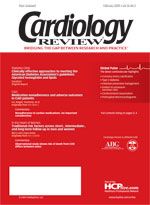Publication
Article
Cardiology Review® Online
Anomalous coronary circulation detected by coronary artery scanning
Author(s):
An asymptomatic 66-year-old man with a history of nonobstructing carotid artery plaque and sleep apnea was referred for cardiac computed tomography (CT) scanning for risk stratification. He exercised on a regular basis with no symptoms and had normal results on at least 2 nuclear stress tests, the last test being performed only 12 months earlier.
An asymptomatic 66-year-old man with a history of nonobstructing carotid artery plaque and sleep apnea was referred for cardiac computed tomography (CT) scanning for risk stratification. He exercised on a regular basis with no symptoms and had normal results on at least 2 nuclear stress tests, the last test being performed only 12 months earlier. He had a CT coronary calcium score of 206, placing him in the moderate plaque burden category. Additional CT coronary imaging showed abnormal coronary circulation, with a single coronary ostium directly off the anterior surface of the aorta giving rise to all 3 coronary arteries (Figure). A significant calcification was noted in the proximal portion of this main trunk. Within days, the patient underwent standard coronary angiography, which showed a 70% narrowing in the proximal portion of the main coronary trunk (single main artery). He subsequently underwent coronary revascularization without complications.
Anomalous coronary arteries have been observed in approximately 0.3% to 1.3% of patients undergoing diagnostic coronary angiography.1 Anomalous circulation has been associated with a range of consequences, from insignificant hemodynamic abnormalities to sudden death.2 In 1 large study, Click and colleagues reviewed angiograms from the Coronary Artery Surgery Study (CASS) and detailed 73 patients with major anomalies, the most common of which involved the circumflex artery (60% of cases).3 Of 24,959 patients, 0.3% had a major coronary anomaly. After the right coronary artery, the left main artery was the third most common anomalous artery. The left anterior descending artery was the least common anomalous artery. In the majority of instances, the left main artery arose from the contralateral sinus. Khanna and colleagues described a case of anomalous origin of the left coronary artery from the pulmonary artery.4
Past studies have suggested a tendency toward accelerated atherosclerosis in coronary anomalies.3,5,6 A large study by Click and colleagues showed similar results of increased stenosis, but mainly in the anomalous circumflex arteries (41% of cases vs 29% of control subjects).3 Despite this, however, survival was not adversely affected.
Hutchins and colleagues theorized that the predisposing factor in atherosclerotic risk relates to the stress-provoking (wall) characteristics of the altered geometric course of the tortuous artery.7 Cheitlin and colleagues confirmed this anomaly as being clinically relevant as a cause of sudden death.8 The postulated mechanism was increased stroke volume during exercise, causing dilation of the aorta and pulmonary trunk, leading to compression of the already narrowed ostium and resulting in diminished coronary blood flow and ischemia. Similarly, the anomalous right coronary artery (arising from the left sinus) has also been implicated in sudden death, presumably by the same mechanism of compression during exercise.9
CT scanning and angiography have been proven effective in detailing anomalous coronary circulation. A study by Datta and colleagues unequivocally displayed the origin of the coronary artery and its course in relation to the great vessels.10 In rare cases, CT angiography reveals findings not conclusively shown by cardiac catheterization.11 In a study by Shi and colleagues, 16 of 242 consecutive patients referred for noninvasive coronary CT imaging were shown to have anomalous coronary arteries.12 The anomalies in all 16 patients were correctly displayed by CT imaging, whereas conventional angiograms alone correctly identified the anomalies in only 52% of the cases.
The case presented illustrates several important points. First, coronary scanning has great utility in showing not only the presence of coronary atherosclerosis but occasionally atherosclerosis in the setting of anomalous circulation. Second, studies have shown electron beam CT (EBCT) to be comparable to exercise radionuclide testing for the detection of obstructive coronary atherosclerosis and for predicting events in asymptomatic women.13 Additionally, Kennedy and colleagues showed calcium score to be a stronger predictor of disease and future events than the sum of all the traditional risk factors combined.14 Arad and colleagues reported that moderate calcium scores were associated with a relative risk of myocardial infarction and cardiac death 10 times higher than that estimated from the Framingham risk index.15
Cardiac CT scanning requires no preparation, can identify disease in a completely asymptomatic patient, and offers identification of anatomy not always discernable by other commonly used technologies.16,17 It is also now available even in somewhat remote areas at low cost compared with standard invasive and noninvasive cardiovascular procedures. Raggi and colleagues even proposed an algorithm using EBCT for those with chest pain at low to intermediate pretest probability of disease, with a significant presumed cost savings projected at approximately 50%.18
We presented a case of anomalous coronary anatomy as shown by cardiac CT scanning that was validated by standard angiogram and led to a life-saving procedure for an asymptomatic patient. Of more than anecdotal interest, studies have confirmed this technology as an accurate and useful tool with great predictive potential.






